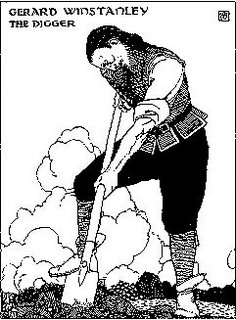"While freely admitting that some of these qualities stem directly from budgetary constraints and the inexperience of the crew, Brownlow defends this admittedly rough-hewn quality, particularly with regard to the use of nonprofessional actors. "Any conviction is killed as soon as most profession actors start 'acting,'" he says, "and this is the trouble with the kind of film Andrew and I like to make. They are supposed to show events that are happening while you watch them, as opposed to enacted historical pageants. If you don't feel these people are real and convincing, ... then we have failed." It is the very absence of calculation and professional polish, adds Brownlow, that is to be desired.
"Winstanley thus belongs to a select company of history films that is rare in the cinema. While it reconstructs a vanished world that displays what historian Simon Schama describes as "an unruly completeness," it also "challenges the truisms of linear history, where the order of events is progressive in both a temporal and a moral sense." In sume, continues Schama:
"These are the films that have respected the strangeness of the past, and have accepted that the historical illumination of the human condition is not necessarily going to be an edifying exercise. ... These are also films that embrace history for its power to complicat, rather than clarify, and warn the time traveler that he is entering a place where he may well lose the thread rather than get the gist."
...
"Winstanley also presented Brownlow with the opportunity to delve into a different kind of historical archive, the archive of the cinema. This is history as a construction of the film medium itself. Brownlow has acknowledged that Winstanley's visual schemas were inspired by the achievements of his favorite filmmakers, most of whom had themselves made historical films. There are allusions to Fescourt and de Baroncelli, for example, "who went back to the actual places in which the stories they were telling occurred and made films that were regional documentaries, albeit very dramatic ones." The carefully composed historical tabealux hark back to the style of D.W. Griffith's America (1924). The frenetic editing of the battle scenes of the film's opening sequence recall Abel Gance's Napoleon (1927) and Orson Welles' The Chimes at Midnight (1966). The use of "typage," i.e., the reliance upon facial types rather than acting abilities to convey character, is reminiscent of the Russians Pudovkin, Eisenstein, and Dovzhenko. And the extraordinary beauty of the landscapes--especially images of the farmers sillhouetted starkly against the windblown skies and meadows--and the naturalistic lighting of the interiors, captured by cinematographer Ernest Vincze (in his theatrical feature film debut), owe much to the Swedish cinema of Mauritz Stiller and Victor Sjostrom (The Treasure of Anne, 1921 and The Outlaw and His Wife, respectively), and the work of Arthur Von Gerlach (The Chronicles of the Gray House, 1925). If Winstanley ultimately seems a graceful relic of the silent era, says Brownlow, that's only as it should be: "If Andrew and I had been courageous enough, we should have made Winstanley as a silent film with a full orchestral track."
-- John C. Tibbetts, "Winstanley; or, Kevin Brownlow Camps Out on St. George's Hill" (Literature Film Quarterly, 2003)

Q: "You felt it had to look like a silent film?"
A: "Well, I live and breathe silent films, as you probably know. I have seen them in their original form and I don't think the exterior photography of that period has ever been excelled--except in Barry Lyndon which can be seen as perhaps the last of the silent films. There are two films which specifically had a direct bearing on Winstanley. One was Dreyer's The Parson's Widow. The other is Artur von Gerlach's Chronicles of the Grey House. Both are extraordinarily strong visually and I think that, despite knowing the seventeenth-century through paintings of the period which are often very colorful, we tend to see it as a black-and-white period. Andrew wanted to do the film in color but he imagined 35mm color which was out of the question financially. 16mm wasn't of sufficiently good quality. Now I've seen Barry Lyndon I think if we'd been able to do it on 35mm in color it would have been sensational. I was at one point thinking of making it a completely silent film--and it would have been a better picture because as soon as you hear dialogue in a historical film, however accurately it is written, pop goes the bubble of illusion. When you look at a recreation like the silent Stiller or Dreyer, of the seventeenth century you feel it indubitably is 1649 and there is no argument about it. Both Andrew and I are obsessed with the minutiae of the past and the creation of the reality of the past. That is probably one of the reasons I am so fascinated by old films. The painstaking recreation of the past is very important, obviously, in this picture. It originally had more commentary, particularly tracing the development of Winstanley's political ideas, but it had to be thrown out. The film fought shy of commentary and we had less and less of it. Most sound films are ninety percent dialogue and this was not going to be one of those films. A film can put over a handful of ideas. It gets stronger the less you ask it to do. So we made this as simple as we possibly could. Hence the title. I thought of lots of titles along The Wind and the Lion lines, The Sword and the Plough-share, lots of Hollywood titles with Max Steiner scores behind them, but it isn't that kind of picture. It is a desperate attempt to simplicity, at absolute purity. That's the idea of it, and that is why it doesn't attempt to do any more than it does."
-- Verina Glaessner, "Winstanley: An Interview with Kevin Brownlow" (Film Quarterly, 1976-77)
(Perhaps a bit more later.)

No comments:
Post a Comment